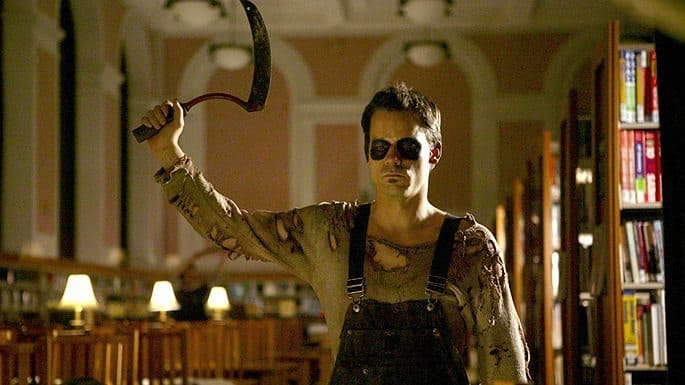Mockbusters: The Documentary’s Evil Sibling: Episode 199
Description
<figure class="aligncenter size-large">
 <figcaption class="wp-element-caption">The magnificent Gene Jones is “Father” in Ti West’s mockumentary: Sacrament (2007)</figcaption></figure>
<figcaption class="wp-element-caption">The magnificent Gene Jones is “Father” in Ti West’s mockumentary: Sacrament (2007)</figcaption></figure>Horror Mockumentaries succeed because of the implied truths they pretend to offer. The authenticity, tangibility, and verisimilitude all convey that what you are watching actually happened. And, it could happen to YOU. Because it is a MOCKumentary and not a DOCumentary, this is all fiction, though, and thank goodness for that. Some of the most brutal and horrific stories originate from this favorite subgenre of horror. Join us in Episode 199, as the Scariest Things investigates the truth of Mockumentaries.
With the release of The Blair Witch Project in 1999, a new dusk arrived in horror. Found footage horror had come of age. Moreover, it employed a quasi-journalistic approach that aimed to convince the audience that what they were watching was evidence. Not all found-footage films are mockumentaries, but a fair number of them utilize the amateur journalistic approach to lend authenticity to the film.
Mockumentaries are the Agent Mulder of the movie world. Let the truth be known! The only other branch of filmmaking that uses mockumentaries, ironically, is comedies. The goal of the mockumentary is to uncover something just under the surface of our daily lives. For movies like Spinal Tap or Best in Show, the premise is to get a peek behind the curtain and understand how absurd these worlds are. Horror mockumentaries choose to reveal how ugly and awful things can be, and that you should be aware of it.
Watch the skies!
The Mocumentary Variants:
The Fake Documentary, or Crime Scene Investigation
This is mockumentary filming at its purest distillation. The film is staged with interviews, voice-over narration, news footage, and still images, exactly like an honest documentary would deliver. These films are told after the fact; a record of heinous events that uncover terrible truths. Many of these films are treated as if they are unraveling deep mysteries and proving conspiracy theories to be real.
This is the academic approach to making horror movies. It aims to explain. The best of the subgenre will have you believing that the story told actually happened. Unsolved mysteries and local cryptid legends get investigated. This is the kind of film that will have you believe that there was research involved, with fact-checking and verification. Ken Burns, eat your heart out!
Best Examples:
- The Poughkeepsie Tapes (2007)
- Strange Harvest: Occult Murder in the Inland Empire (2024)
- Hell House LLC (2015)
- The Fourth Kind (2009)
- Lake Mungo (2008)
- Incident at Loch Ness (2004)
- Horror in the High Desert (2021)
- Savageland (2015)
- Antrum (2018) (…at least the intro to Antrum)
<figure class="wp-block-image size-full">
 <figcaption class="wp-element-caption">Peter Zisso in Strange Harvest: Occult Murders in the Inland Empire (2024)</figcaption></figure>
<figcaption class="wp-element-caption">Peter Zisso in Strange Harvest: Occult Murders in the Inland Empire (2024)</figcaption></figure>The Obsessive True Believer
Here is the medium for the Blair Witch Project. This variant takes full advantage of the amateur investigator. Grab a camera. Go into the woods and find out what’s really out there. The “filmmakers” are on a wumpus hunt. If we can uncover the truth, if we find the proof, I will be vindicated! More often than not, the reason this is called found footage is that the investigators did uncover the truth, but ultimately paid the price for their efforts with their own lives, leaving behind the evidence next to their corpses.
Best Examples:
- The Blair Witch Project (1999)
- Frogman (2023)
- Trollhunter (2010)
- Noroi: The Curse (2005)
- Deadstream (2022)
The Dogged Journalist on a Doomed Assignment
Breaking news! There’s a monster in the river. Go check it out. I’m sure it is safe. This variant of the trope isn’t like the obsessive true believer, because this is a job. The camera crew is sent out to report something happening, and hopefully beat the local competition to the scene. Better yet, if you can get embedded at the scene, you may get prime footage for the evening news. More stable than most shaky cam movies, these films feature professional camera operators and sound crews, resulting in less nausea-inducing camera shake.
Best Examples:
- Punishment Park (1971)
- The WNUF Halloween Special (2013)
- [REC] (2007)
- The Bay (2012)
- Grave Encounters (2011)
The Unfortunate Exclusive Interview
I’ve heard that this guy is a bit of a weirdo. I bet he’ll make good coverage. He won’t hurt me, I’ll make him my friend! He promised me an exclusive, and we can follow him around to uncover some dirty secrets. This is gonna be great! Famous last words. These weirdos have a plan. Often, that plan turns on the documentary crew. That’s how these situations typically unfold.
These films often feature extensive question-and-answer sessions with the weirdo. Perhaps the crew should have wondered why they were granted access in the first place. These journalists usually lack the wisdom to sense when this might be a trap. This is why these reporters tend not to end up in a sequel. (Stab! Stab!)
This grouping also covers the unfortunate case study, which is sometimes like the obsessive true believer, but the motivations are usually more academic than Quixotic.
- The Sacrament (2013)
- Digging Up the Marrow (2014)
- The Taking of Deborah Logan (2014)
- Creep (2014)
- Behind the Mask: The Rise of Leslie Vernon (2006)
- 15 Things You Didn’t Know About Bigfoot (#1 Will Blow Your Mind!) (2019)
- Cannibal Holocaust (1980)
- What We Do in the Shadows (2014)
- The Ceremony is About to Begin (2024)
<figure class="aligncenter size-full">
 <figcaption class="wp-element-caption">Nathan Baesel in Behind the Mask: The Rise of Leslie Vernon (2006)</figcaption></figure>
<figcaption class="wp-element-caption">Nathan Baesel in Behind the Mask: The Rise of Leslie Vernon (2006)</figcaption></figure>The Thin Line between Mockumentaries and Promoting Pseudoscience
But wait, you may be thinking, what about films and shows that promote the actual presence of pseudoscience as fact? Television shows like Ancient Aliens and Ghosthunters are manipulative programs that propose that cryptids are real. Aliens are responsible for the scientific advancement of human society. Most of the audience gets it. This is pure bullshit, and we want to see if the producers can convince us that they have found ghosts. Unfortunately, whether or not these filmmakers believe their theories, this becomes part of the process of dumbing down society. Fantasy is being presented as science. Fake news.
I grew up loving In Search Of, with Leonard Nimoy, back in the late 70’s. That show at least offered up the possibility of cryptids, but it took a nuanced look at what might be. They never claimed to have the evidence to prove the mystery true, but they explained the mystery. That’s fair game.
That said, I love horror mockumentaries. They take the preposterous right to the edge of credibility, and wink at us. And then they throw the proverbial bucket of blood onto us and grin. I’m down for that.
Don’t Confuse Mockumentaries with Mockbusters
In the podcast, we discussed the difference between these two terms, perhaps more thoroughly than necessary, but I have decided to add some clarity. There is another term in the horror film industry that is frequently used: Mockbusters. The Mockbuster is a production from a smaller production house that associates itself with a successful title and tries to convince you that it will be, by comparison, equally cool.
This is a huge pet peeve for one of our writers, Robert Zilbauer, as he can fall prey to the mockbuster, thinking that a film might have potential. The film studios The Asylum, which gave us Sharknado, and the Polonia Brothers, who made Amityville





